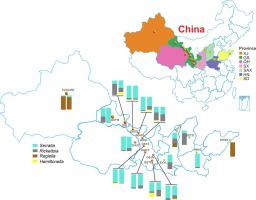Journal of Asia-Pacific Entomology ( IF 1.5 ) Pub Date : 2021-07-07 , DOI: 10.1016/j.aspen.2021.07.001 Li Zhang 1, 2 , Ya Cao 1 , Li-Jun Zhang 1 , Meng-Yao Wang 1 , Xiao-Tong Wang 1 , Xing-Zhuo Yang 1 , Ting-Yu Duan 1 , Ming-Long Yuan 1

|
Bacterial symbionts in aphids are known to benefit the insect host and associated with aphid’s ecological adaptation. The pea aphid (Acyrthosiphon pisum), an important legume pest worldwide, carries at least eight endosymbionts, providing a model system to study insect–bacteria interactions. However, species diversity and geographic variations of endosymbionts are unknown in Chinese populations; therefore, we characterized symbiont communities and diversity of 27 pea aphid samples from 13 geographic populations of China. Via amplicon high-throughput sequencing and diagnostic PCR, we found that bacterial communities of Chinese populations were dominated by Proteobacteria and Firmicutes. Among eight known endosymbionts, five (Buchnera, Serratia, Hamiltonella, Regiella, and Rickettsia) were detected by both methods, with a specific geographical distribution. The obligate symbiont, Buchnera, was present in all aphid samples, while the four facultative symbionts showed a significant geographic variation. Each population was randomly infected with distinct endosymbionts, ranging from three to five species. Serratia and Rickettsia showed relatively higher abundance in central regions of China, Regiella was predominant in eastern and western China, whereas Hamiltonella showed an extremely low abundance and was absent in four populations. Samples grouped by altitudes showed a significant diversity difference, whereas there was no significant difference between red and green body colors. Bacterial community structures of the Chinese pea aphid populations were mainly influenced by environmental factors, other than body colors. These data can guide the development of potential biocontrol techniques against this aphid.


























 京公网安备 11010802027423号
京公网安备 11010802027423号